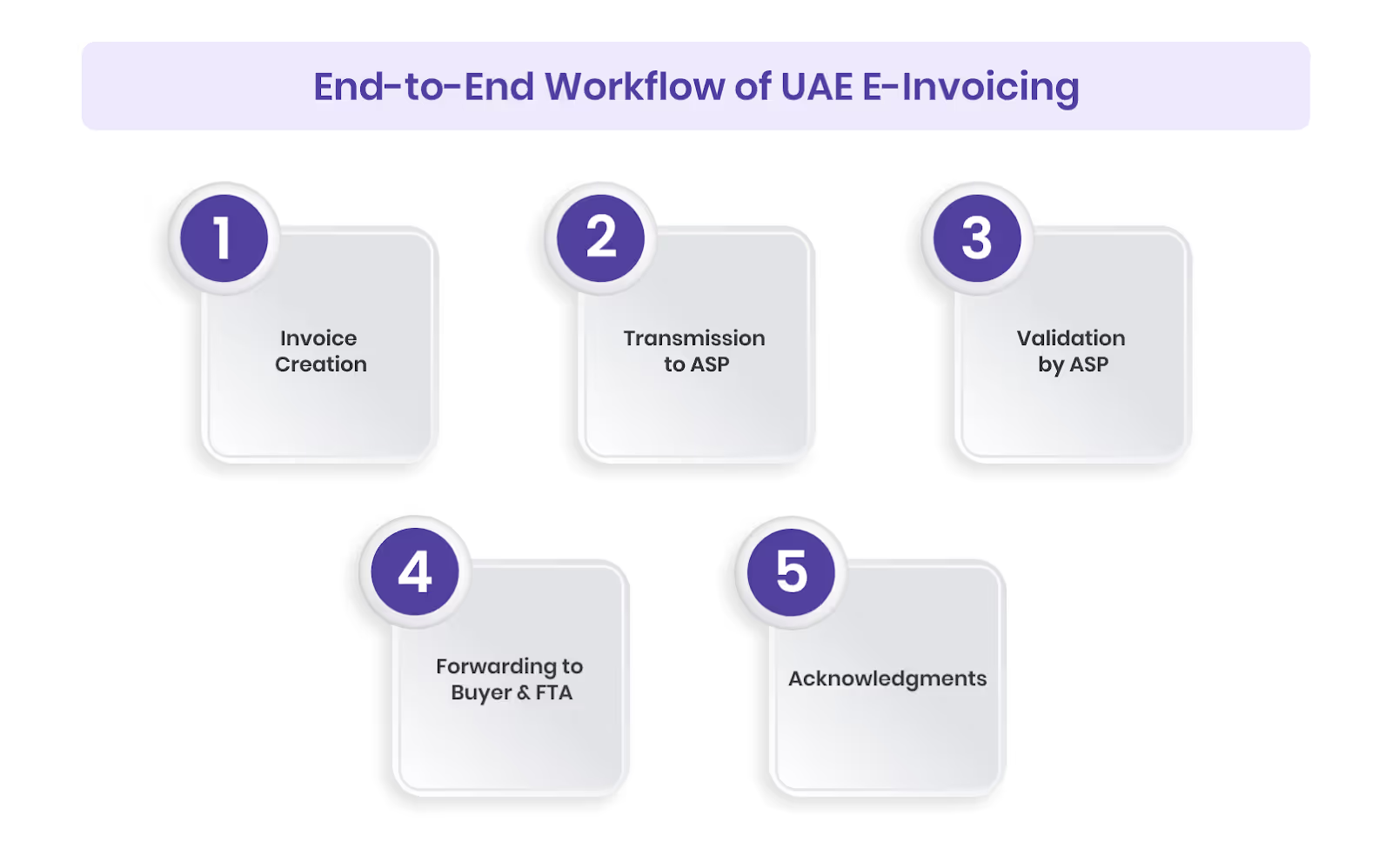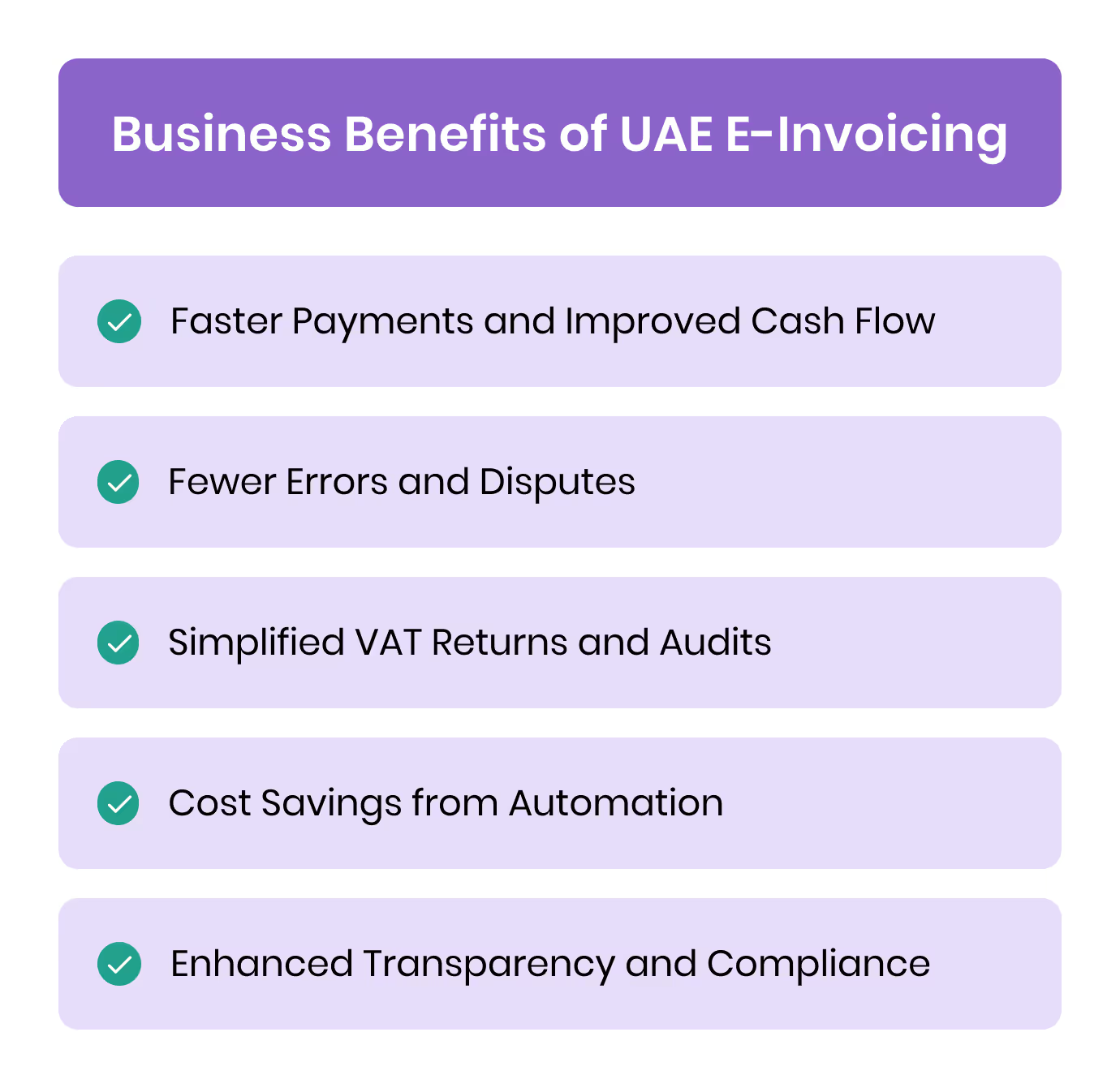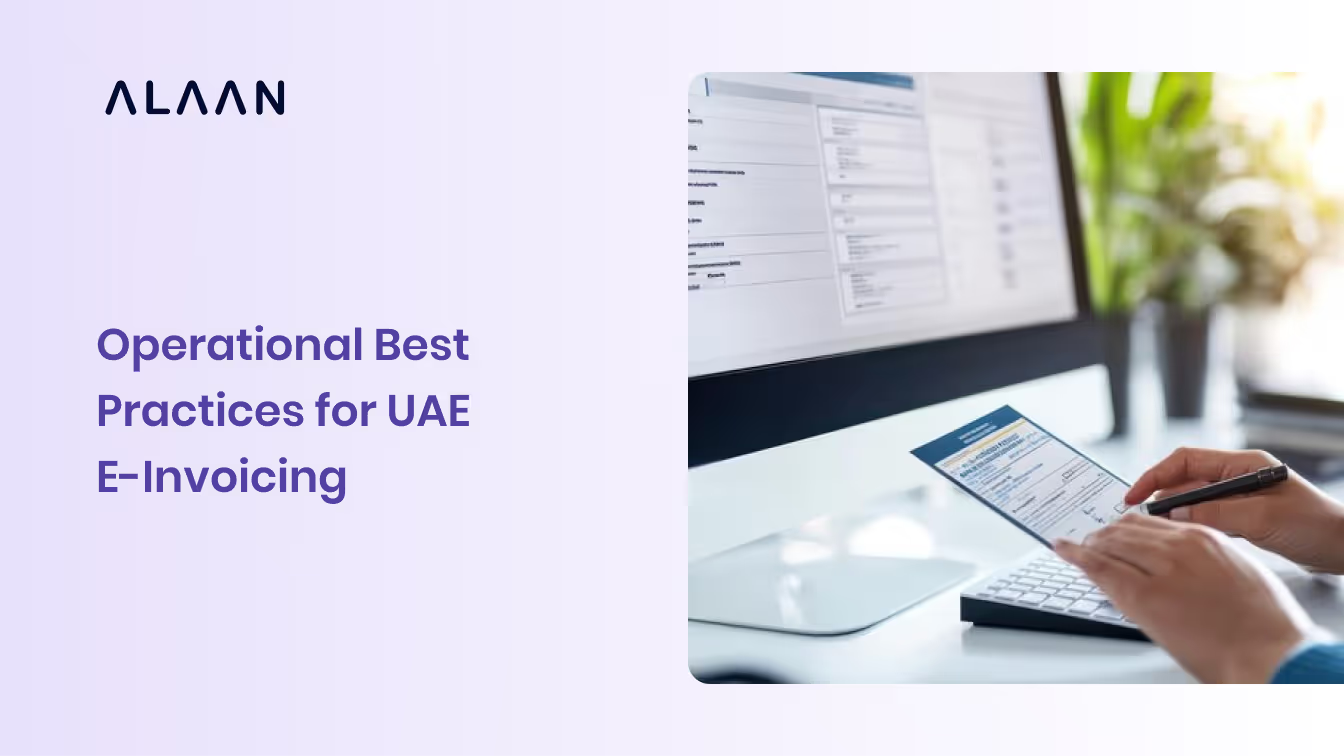As the UAE moves closer to its July 2026 e-invoicing mandate, the real challenge for businesses is not just meeting the deadline, but embedding e-invoicing into daily finance operations. Compliance must become routine, with finance teams equipped to generate, validate, and monitor e-invoices seamlessly.
The good news? When managed correctly, e-invoicing brings more than regulatory peace of mind. It helps businesses accelerate payments, reduce costs, and improve accuracy in financial reporting. In this guide, we’ll walk through operational best practices: from setting up workflows to troubleshooting errors, avoiding pitfalls, and building a culture of continuous compliance.
Standard UAE E-Invoicing Workflow

A compliant e-invoicing process in the UAE follows a standardized workflow defined by the Ministry of Finance (MoF) and the Federal Tax Authority (FTA). Understanding this sequence is critical, as errors at any stage can result in rejected invoices or delayed payments.
Here’s what the typical end-to-end workflow looks like:
1. Invoice Creation
The supplier’s Accounts Receivable (AR) team creates the invoice in their ERP or accounting system. All mandatory fields — such as supplier and buyer TRNs, VAT breakdown, and unique invoice reference numbers — must be captured.
2. Transmission to ASP
The ERP sends invoice data to the business’s Accredited Service Provider (ASP). ASPs act as gateways, ensuring invoices comply with the UAE’s PINT AE XML standard.
Source: Ministerial Decision document
3. Validation by ASP
The ASP validates the invoice format and tax details. Errors such as missing TRNs or incorrect VAT calculations are flagged for correction before the invoice proceeds further.
- Forwarding to Buyer and FTA
Once validated, the ASP forwards the e-invoice to:- The buyer’s ASP, which delivers the invoice into the buyer’s system.
- The FTA, which receives tax data in real time for compliance monitoring.
- Acknowledgments
Both the supplier and the buyer receive Message Level Status (acknowledgments) confirming whether the invoice has been delivered and reported successfully. (Reference: VATUpdate, 2025)
Important: An invoice is only considered issued once it has been validated, delivered to the buyer, and successfully reported to the FTA.
Error Handling & Troubleshooting
Even with accredited ASPs validating invoices, errors can still occur during creation, transmission, or reporting. Building clear error-handling processes ensures that invoices are corrected quickly and payments are not delayed.
Common Errors and How to Fix Them
- Validation Error: Missing TRN
Cause: The supplier or buyer’s Tax Registration Number (TRN) is missing or incorrect.
Fix: Update the customer/vendor master data in your ERP and re-send the invoice. - Syntax Error in XML
Cause: The ERP or connector generated an invoice that doesn’t match the PINT AE schema.
Fix: IT or ASP support must review mapping rules and update the configuration to align with the latest MoF specifications. - Incorrect VAT Calculation
Cause: Wrong VAT rate or misclassification of supply.
Fix: Verify tax codes in your ERP are aligned with the FTA’s published VAT rules. - Late Submission
Cause: Invoice not reported to the FTA within the required time (invoices must be transmitted in near real-time).
Fix: Avoid batching invoices at month-end. Automate submissions to occur immediately upon issuance.
Best Practices for Error Management
- Automated Checks: Configure ERP or ASP systems to flag missing fields or incorrect tax rates before invoices are sent.
- ASP Dashboards: Most ASPs provide dashboards showing invoice status (sent, accepted, rejected, pending). Finance teams should review these daily.
- Exception Handling: Establish a clear internal workflow for resolving rejected invoices, including assigning responsibility (e.g., AR team for data errors, IT for schema issues).
Did you know?
If an invoice fails validation and is rejected by the buyer’s ASP or the FTA, it must be corrected and re-sent promptly. The FTA tracks all attempts, so consistent errors may trigger compliance reviews.
Avoiding Pitfalls in Daily Operations
Even with the right systems in place, day-to-day operations can present challenges. Anticipating and planning for these pitfalls will keep your e-invoicing process smooth and compliant.
1. Duplicate Invoices
It’s possible to send the same invoice twice — especially if teams try to “resend” after an error without checking status messages. Duplicate invoices must be voided with a credit note to avoid double reporting.
Pro Tip: Set up automated reference number checks in your ERP or ASP to prevent duplicates from being issued.
2. Incorrect Tax Data
Invoices with wrong VAT rates or misclassified supplies are a common reason for rejection. This often happens when master data in ERP systems is outdated.
Best practice: Align VAT codes in your ERP with the latest FTA VAT rules and review them regularly.
3. System Downtime
If an ASP’s platform or ERP connector is down, invoices may fail to transmit to the FTA. Some ASPs provide offline upload or queuing mechanisms that allow invoices to be submitted once connectivity is restored.
Best practice: Agree on a contingency plan with your ASP and ensure your finance team knows how to execute it.
4. Rejected Invoices and FTA Monitoring
Rejected invoices must be corrected and re-sent quickly. The FTA monitors all submission attempts, and repeated rejections can raise compliance red flags.
Did you know? If your invoice is rejected by the buyer’s ASP or the FTA, it is not legally valid until corrected and resubmitted.
5. Testing Ahead of Go-Live
Many ASPs are required to offer at least 100 free transactions per year for testing purposes. Businesses can use these to trial their invoicing process before the mandate.
Pro Tip: Send low-value invoices to yourself or a trusted client during testing. This helps confirm the full workflow — creation, validation, submission, acknowledgment — before July 2026.
Continuous Compliance Practices
Compliance with e-invoicing is not a one-time setup — it requires ongoing monitoring and operational discipline. The most effective businesses build e-invoicing checks directly into their finance routines.
Daily Practices
- Verify that all invoices issued the previous day show FTA acknowledgment.
- Monitor ASP dashboards for any rejections or pending submissions.
- Ensure staff are resolving flagged errors before new invoices are processed.
Monthly Practices
- Reconcile the total number and value of invoices reported to the FTA with internal ERP records and VAT returns.
- Review credit notes and cancellations to confirm they have been transmitted properly.
- Conduct a spot check of archived invoices to confirm searchability and retrievability.
Quarterly Practices
- Run an internal mini-audit: sample invoices against VAT return data.
- Validate ERP master data (customer TRNs, VAT codes, supply categories).
- Review ASP system updates to ensure the latest schema versions are in use.
Long-Term Archiving
Under UAE VAT law, businesses must store invoices electronically for at least 5 years, and in some cases longer (up to 10–15 years for capital assets and real estate). ASPs may provide archiving services, but businesses should ensure data is exportable and retrievable on demand.
Quick Reference: Compliance Operations Checklist
Tip: Assign specific owners for each compliance task (e.g., AR manager for daily checks, tax manager for monthly reconciliations) to avoid gaps.
Benefits of Operational Excellence in E-Invoicing

When e-invoicing is implemented as more than just a compliance requirement, businesses unlock tangible operational and financial benefits. The UAE’s adoption of the Peppol-based model makes these gains especially accessible.
Faster Payments and Improved Cash Flow
E-invoices transmitted through ASPs are validated and delivered almost instantly. Buyers receive invoices directly into their systems, reducing processing delays and enabling quicker approvals. This can shorten payment cycles and improve working capital — a key advantage for SMEs.
Fewer Errors and Disputes
Automated validation reduces common errors like incorrect VAT rates or missing TRNs. With fewer rejected invoices, businesses spend less time resolving disputes and more time focusing on growth.
Simplified VAT Returns and Audits
Digital records mean invoices can be retrieved and reconciled quickly. The FTA’s real-time reporting capability also opens the door to pre-filled VAT returns in the future, easing the administrative burden on finance teams (PwC UAE, 2025).
Cost Savings from Automation
Studies in other jurisdictions have shown that e-invoicing can reduce invoice processing costs by up to 60–66% compared to manual or paper-based methods. Reduced printing, storage, and administrative effort translates into real savings over time.
[cta-1]
Enhanced Transparency and Compliance
Because invoices are monitored in near real-time by the FTA, businesses that follow best practices demonstrate stronger compliance, reducing the risk of audits or penalties. This also builds trust with trading partners who rely on valid, VAT-compliant invoices for input tax recovery.
Operational excellence in e-invoicing does more than keep you compliant — it makes finance processes faster, leaner, and more resilient.
Key Takeaways: Operational Best Practices for UAE E-Invoicing
- Map your workflow — align your internal invoice process with the UAE’s e-invoicing flow (ERP → ASP → Buyer + FTA).
- Validate data early — ensure TRNs, VAT codes, and mandatory fields are correct before sending invoices.
- Use ASP dashboards — monitor invoice status daily to catch rejections or pending submissions.
- Avoid common mistakes — prevent duplicates, incorrect VAT rates, or delayed submissions through automation and staff training.
- Reconcile regularly — match invoices against VAT returns monthly and run quarterly mini-audits.
- Maintain archiving discipline — store e-invoices for at least 5 years (longer for specific asset categories).
- Leverage automation — treat e-invoicing as a chance to reduce costs and speed up payments, not just a compliance task.
Businesses that adopt these practices early will find compliance seamless while also improving efficiency, cash flow, and audit readiness.
How Alaan Supports Operational Compliance
E-invoicing is not just about issuing XML files — it’s about ensuring that every invoice flows smoothly from ERP to ASP to the FTA, without errors or delays. This requires ongoing monitoring, reconciliation, and reliable archiving.
With Alaan, businesses can:
- Automate compliance checks to catch missing TRNs or invalid VAT codes before invoices are transmitted.
- Monitor invoice status in real time through dashboards that show which invoices have been accepted or rejected.
- Simplify record-keeping by maintaining audit-ready invoice archives for the required retention period.
- Reduce manual effort by integrating spend management and invoicing into a single streamlined process.
[cta-6]
By embedding these capabilities into everyday finance workflows, Alaan helps companies meet FTA requirements while also improving operational efficiency.
Conclusion
As the UAE enters the final stretch before the July 2026 e-invoicing mandate, businesses must move beyond initial setup and focus on operational excellence. Daily monitoring, error handling, and continuous compliance routines are what keep invoices valid, payments flowing, and audit risks low.
The reality is clear: e-invoicing success lies in process discipline. Companies that embed best practices into their operations will not only stay compliant but also unlock faster payments, lower costs, and stronger vendor and customer relationships.
At Alaan, we believe compliance should be seamless, not burdensome. Our platform empowers finance teams to stay compliant effortlessly while driving efficiency and control across invoicing and spend management.
Book a demo with Alaan today and see how we can help you future-proof your invoicing operations.
Frequently Asked Questions (FAQs) on UAE E-Invoicing Operations
1. What happens if my invoice is rejected by the ASP or FTA?
A rejected invoice is not legally valid. The supplier must correct the error (e.g., missing TRN, incorrect VAT calculation, invalid XML format) and re-send it. Payments may be delayed until the invoice is accepted and reported to the FTA.
2. How can I prevent duplicate invoices?
Duplicate invoices occur when a team re-sends without checking acknowledgment messages. The best practice is to use unique invoice reference numbers and configure your ERP or ASP to block duplicates. If one is sent by mistake, cancel it with a credit note.
3. How quickly must invoices be reported to the FTA?
Invoices must be reported in near real time. Delays (e.g., batching submissions at month-end) risk non-compliance. Automating submission through your ASP ensures invoices are transmitted as soon as they are issued.
4. What should I do if my ASP has downtime?
Check whether your ASP offers an offline upload or queuing mechanism. Businesses should also agree on a contingency plan with their provider and document internal escalation procedures.
5. How often should I reconcile invoices with VAT returns?
At a minimum, reconciliation should be done monthly to match invoices against VAT return totals. Many companies also perform quarterly mini-audits to ensure archiving, VAT treatment, and reporting are consistent.
6. How long must I keep e-invoices in the UAE?
Businesses must store invoices electronically for at least 5 years. Certain categories (like capital assets or real estate) may require longer retention of up to 10–15 years under VAT rules.


.avif)







